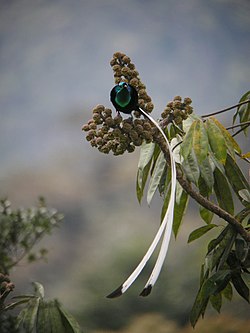Mating and breeding
Breeding behaviors are not well known, but all species are thought to be polygamous, with promiscuous males that use arboreal display sites, and with females providing all parental care. [9] Summaries from species accounts indicate a few simple behaviors including a form of hoping back and forth between branches and an inverted display posture in A. rothschildi. [6] At traditional sites in the forest canopy, Astrapia stephaniae is known to form leks. [6] [10]
There are seven distinct male courtship displays that have been documented: perch-hopping, pivoting, inverted tail-fanning, nape-pecking, post-copulatory tumbling, upright sleeked posturing and branch-sidling. [6] Of the male behaviors, perch-hopping is the most broadly distributed among all species but A. nigra. In all of them, the displaying bird moves quickly between multiple branches by hopping or making short flight-hops. In A. rothschildi, hopping between perches sometimes includes chasing females (or female plumaged individuals). It is unclear if chasing is a component of perch-hopping in the other species. [6]
A type of pivot display is known from two species, A. rothschildi and A. mayeri . In both, it involves repeatedly moving in a ritualized fashion from side-to-side with feet more-or-less in a fixed position. The most distinctive feature of the A. rothschildi pivot is wing flicking, whereas in A. mayeri the most distinctive features are the very ritualized hunchbacked posture and the highly exaggerated swishing movement of the male's long ribbon-like tail. [6]
The Arfak astrapia and the Huon astrapia have a distinctive and specialized display behavior, which is called the inverted tail-fan display. When the abdominal feathers are sky-oriented during the display, their green iridescent feathers (that would appear otherwise dark) become highly visible; the splendid astrapia also has highly iridescent green abdominal plumage, which raises the question about if it too has an undocumented inverted display behavior.









